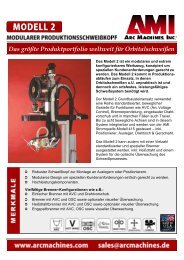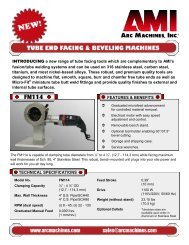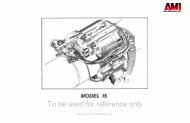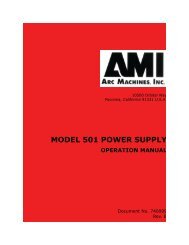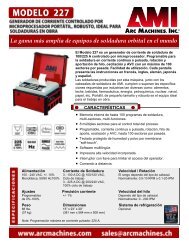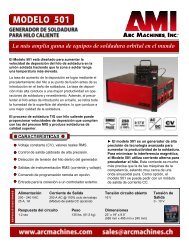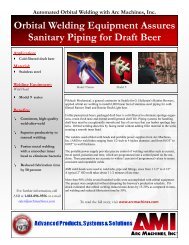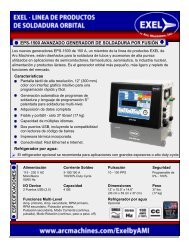Considerations for Orbital Welding of Corrosion ... - Arc Machines, Inc.
Considerations for Orbital Welding of Corrosion ... - Arc Machines, Inc.
Considerations for Orbital Welding of Corrosion ... - Arc Machines, Inc.
Create successful ePaper yourself
Turn your PDF publications into a flip-book with our unique Google optimized e-Paper software.
<strong>Considerations</strong> <strong>for</strong> <strong>Orbital</strong> <strong>Welding</strong> <strong>of</strong><br />
<strong>Corrosion</strong> Resistant Materials to the ASME<br />
Bioprocessing Equipment (BPE) Standard<br />
Barbara K. Henon, Ph.D., <strong>Arc</strong> <strong>Machines</strong>, <strong>Inc</strong>.<br />
Presenter:<br />
��<br />
Barbara K. Henon<br />
Academic Education:<br />
1976 Ph.D. Biological Sciences, University <strong>of</strong> Southern Cali<strong>for</strong>nia<br />
1961 M.A. Zoology, Columbia University<br />
1958 B.A. Zoology, Mount Holyoke College<br />
Present Pr<strong>of</strong>essional Position:<br />
Manager Technical Publications, <strong>Arc</strong> <strong>Machines</strong>, <strong>Inc</strong>.<br />
Standards Committees:<br />
ASME Bioprocessing Equipment (BPE) Standard (Since 1989)<br />
AWS D18 and D10 Committees<br />
Liaison between ASME BPE and ASME B31.3 Process Piping<br />
Presented on the Stainless Steel America Conference 2008
<strong>Considerations</strong> <strong>for</strong> <strong>Orbital</strong> <strong>Welding</strong> <strong>of</strong><br />
<strong>Corrosion</strong> Resistant Materials to the ASME<br />
Bioprocessing Equipment (BPE) Standard<br />
Barbara K. Henon, Ph.D., <strong>Arc</strong> <strong>Machines</strong>, <strong>Inc</strong>.<br />
Keywords: orbital welding, 316L stainless steel, super-austenitic stainless steel,<br />
duplex stainless steel, ASME Bioprocessing Equipment (BPE) Standard, BPE,<br />
pharmaceutical industry piping, autogenous orbital welding, orbital welding with<br />
filler wire<br />
Abstract<br />
The ASME Bioprocessing Equipment Standard (BPE), first published in 1997,<br />
(current edition 2007) recommends the use <strong>of</strong> 316L stainless steel <strong>for</strong> tubing<br />
systems, system components and equipment <strong>for</strong> bioprocessing, pharmaceutical<br />
and personal care facilities where high purity and process control are essential.<br />
The BPE Subcommittee on Metallic Materials <strong>of</strong> Construction (MMOC) is<br />
currently working on a draft <strong>of</strong> a Part to be added to the BPE Standard which will<br />
expand the selection <strong>of</strong> acceptable metallic materials <strong>of</strong> construction to include 6<br />
Mo super-austenitic stainless steels such as Al-6XN and some duplex stainless<br />
steel alloys. The MMOC Subcommittee will also define a method by which other<br />
metallic materials <strong>of</strong> construction may be submitted <strong>for</strong> consideration.<br />
While 316L stainless steel tubing welded to the BPE Standard is routinely joined<br />
by autogenous orbital GTA welding, other alloys may require the addition <strong>of</strong><br />
appropriately enriched filler material in order to maintain their corrosion<br />
resistance after welding. The use <strong>of</strong> insert rings higher in alloying elements than<br />
the base material has proven to be an acceptable method <strong>for</strong> welding <strong>of</strong> Al-6XN<br />
tubing <strong>of</strong> 0.065 inch wall thickness. This can be accomplished using orbital fusion<br />
welding equipment. The insert rings are manually tack welded in position and<br />
welded in an orbital weld head designed <strong>for</strong> autogenous welding.<br />
While autogenous orbital welding has become routine in the biopharmaceutical<br />
and related industries, orbital welding with the addition <strong>of</strong> filler wire is generally<br />
unfamiliar. In-place welding in the field using manual GTA welding with the<br />
addition <strong>of</strong> filler wire is very unlikely to achieve a smooth inner weld bead.<br />
Smooth inner weld beads are necessary <strong>for</strong> the cleanability <strong>of</strong> high purity tubing<br />
systems which are used in these industries. <strong>Orbital</strong> GTA welding with the<br />
addition <strong>of</strong> wire is a viable option. This presentation will discuss the ASME BPE<br />
Standard, and the techniques, tube end preparation, equipment considerations<br />
and operator training requirements <strong>for</strong> orbital welding <strong>of</strong> corrosion resistant<br />
materials <strong>for</strong> the above mentioned industries.
1 Introduction: The ASME Bioprocessing<br />
Equipment (BPE) Standard<br />
Most, if not all, new biotech and pharmaceutical installations in the United States<br />
and many in Europe use the American Society <strong>of</strong> Mechanical Engineers (ASME)<br />
Bioprocessing Equipment (BPE) Standard 1 . The BPE Standard covers the<br />
design <strong>of</strong> equipment used in the bioprocessing, pharmaceutical and product care<br />
industries. The Standard also covers aspects which relate to sterility and<br />
cleanability such as plant piping. The piping area <strong>of</strong> the Standard includes<br />
guidance on: materials, dimensions and tolerances, surface finish, and material<br />
joining. The BPE Standard, was first published in 1997 as an American National<br />
Standard. With the 2002 Edition, the BPE Standard became an International<br />
Standard and it is now recognized in at least 30 countries. The current edition is<br />
the 2007 revision.<br />
Materials <strong>of</strong> construction <strong>for</strong> the biotech and pharmaceutical industries must be<br />
resistant to corrosion from high purity water as well as buffer solutions used in<br />
the preparation <strong>of</strong> products and cleaning solutions used <strong>for</strong> CIP. Type 316L (UNS<br />
No. S31603) was initially specified by the BPE <strong>for</strong> bioprocessing equipment<br />
because it is sufficiently corrosion resistant <strong>for</strong> most bioprocess applications, the<br />
material was commercially available and it <strong>of</strong>fers ease <strong>of</strong> fabrication. The 2007<br />
Edition <strong>of</strong> the BPE Standard mentions that higher grade materials, such as the 6-<br />
Moly superaustenitic alloys (AL6-XN, UNS N08367, is the example listed), or<br />
2205 duplex stainless steel (UNS S31803 or S32205) may also be used. The<br />
owner/user is responsible <strong>for</strong> the selection <strong>of</strong> appropriate materials <strong>of</strong><br />
construction <strong>for</strong> the specific process.<br />
It is not enough to specify the use <strong>of</strong> a corrosion resistant alloy, since without<br />
proper materials handling, fabrication techniques and welding procedures much<br />
<strong>of</strong> the corrosion resistance <strong>of</strong> the base material may be lost. Recognizing the<br />
need <strong>for</strong> a comprehensive approach, the BPE standard was one <strong>of</strong> the first<br />
standards to specify automatic or machine welding processes such as orbital<br />
welding as the preferred joining technology, and 316L stainless steel <strong>for</strong> tubing<br />
and weld components <strong>for</strong> hygienic tubing systems 2 . In today’s biopharmaceutical<br />
environment, where 20,000 to 30,000 welds may be required to complete a<br />
process piping installation, virtually 100% <strong>of</strong> the field welds on product contact<br />
surfaces are now done with orbital welding. <strong>Orbital</strong> welding, by definition is:<br />
“automatic or machine welding <strong>of</strong> tubes or pipe in-place with the electrode<br />
rotating (or orbiting) around the work”. <strong>Orbital</strong> welding, as it applies to the<br />
biotech-pharmaceutical industry, uses the gas tungsten arc welding (GTAW)<br />
process in which the welds are usually done autogenously, that is, the ends <strong>of</strong><br />
the tubing are fused together without the use <strong>of</strong> additional filler metal. However,<br />
the use <strong>of</strong> GTAW with the addition <strong>of</strong> wire is permitted and may be appropriate<br />
<strong>for</strong> some alloys or applications. <strong>Orbital</strong> welding <strong>of</strong>fers the advantage that once<br />
acceptable welding procedures have been developed <strong>for</strong> a particular heat <strong>of</strong>
material, the power supply can reproduce identical weld parameters <strong>for</strong> every<br />
weld in the system. The BPE now requires the permission <strong>of</strong> the owner in order<br />
to make a manual weld on a joint to be done on a product contact surface.<br />
2 <strong>Orbital</strong> GTAW equipment <strong>for</strong> autogenous<br />
and wire feed applications<br />
Pharmaceutical tubing (ASTM A270 S2) 3 is generally thin wall, i.e., 0.065 inch <strong>for</strong><br />
diameters from 1 to 3 inches, and 0.083 inches <strong>for</strong> 4 inch diameter tubing. <strong>Orbital</strong><br />
wire feed equipment is typically used <strong>for</strong> heavier wall on pipe diameters from 4<br />
inch pipe and up. And, although orbital welding with wire has been used<br />
successfully on small diameter duplex stainless steel in the <strong>of</strong>fshore industry, this<br />
technology is virtually unknown in the fabrication <strong>of</strong> pharmaceutical piping<br />
systems.<br />
2.1 <strong>Orbital</strong> weld heads: Enclosed vs. open frame<br />
The equipment used <strong>for</strong> orbital welding with the addition <strong>of</strong> wire differs in several<br />
important ways from that used <strong>for</strong> autogenous orbital welding (Fig. 1). The<br />
enclosed weld heads used <strong>for</strong> autogenous orbital welding provide a continuous<br />
shield with inert gas flowing <strong>for</strong> the entire weld joint during prepurge, the weld<br />
sequence, and postpurge which allows cooling <strong>of</strong> the weldment be<strong>for</strong>e exposing<br />
it to atmosphere.<br />
With the orbital open frame heads used <strong>for</strong> adding wire the shield gas is limited<br />
to the electrode and the weld pool directly beneath the electrode. The resulting<br />
weld has considerably more heat tint discoloration on the OD surface than with<br />
Fig. 1: Left: an orbital weld head used <strong>for</strong> autogenous welding. During<br />
welding the entire outside surface <strong>of</strong> the weld joint is protected by inert gas<br />
shielding. Right: an open-frame orbital weld head is shown welding a duplex<br />
stainless steel tube. Wire is being added to the weld. The gas cup provides<br />
shielding <strong>of</strong> the tungsten electrode and weld pool only. The welded surface<br />
is exposed to atmosphere be<strong>for</strong>e it has entirely cooled. Photos courtesy <strong>of</strong><br />
<strong>Arc</strong> <strong>Machines</strong>, <strong>Inc</strong>.
an enclosed head. The ID purge is controlled independently <strong>for</strong> both autogenous<br />
and wire feed welding and achieving a clean color-free weld on the ID depends<br />
on the gas quality and the purge set up and techniques. With an enclosed head,<br />
however, it is possible to adjust the ID purge pressure to prevent ID convexity<br />
and achieve a flat inner weld bead surface which is ideal <strong>for</strong> biopharmaceutical<br />
applications. The pressure balancing technique does not work with an open<br />
frame weld head and some inner weld bead rein<strong>for</strong>cement occurs.<br />
With an enclosed weld head the tubing and/or components are held in position<br />
using tube clamp inserts or collets <strong>for</strong> the exact tube diameter that are installed<br />
on both sides <strong>of</strong> the weld head. The electrode is lined up to the joint. Once the<br />
START button is pushed, the entire process is completely automatic. For an open<br />
frame head, the joint components must be tack welded in place or a bridge clamp<br />
used. A clamp on one side <strong>of</strong> the head holds the tube or pipe. The head must be<br />
properly aligned with respect to the weld joint and the wire angle and wire<br />
distance from the joint set. <strong>Orbital</strong> welding with wire feed is not fully automatic.<br />
Some adjustments such as torch steering to track the joint or adjustment to arc<br />
gap may be required. This takes considerably more operator skill than<br />
autogenous welding. While a welding operator can be trained <strong>for</strong> autogenous<br />
welding in two days, a minimum <strong>of</strong> four days is required to train an operator <strong>for</strong><br />
wire feed orbital welding. Experience with manual welding is particularly helpful<br />
<strong>for</strong> wire feed operators who must be able to “read the puddle” in order to make<br />
parameter adjustments during welding.<br />
Water cooling <strong>of</strong> the cables and weld heads is done to prevent damage to the<br />
weld head from excessive heat and thereby to improve productivity.<br />
2.2 <strong>Orbital</strong> GTAW power supplies.<br />
Power supplies are microprocessor based and control all <strong>of</strong> the weld parameters.<br />
The parameters <strong>for</strong> a particular diameter, wall thickness <strong>of</strong> tube or pipe are<br />
stored in memory as weld schedules. These schedules are reproduced and<br />
applied consistently <strong>for</strong> each weld joint. In addition to the welding current, travel<br />
speed, pulse times, level times or position used in autogenous welding, power<br />
supplies with wire feed capabilities have additional controls. As a minimum this<br />
would include wire feed speed and provisions to advance or retract the wire. In<br />
addition full function weld heads have controls <strong>for</strong> oscillation <strong>of</strong> the torch across<br />
the weld joint and electronic arc gap control (AVC) that maintains the correct<br />
distance between the electrode tip and the weld joint. The power supply must<br />
have the capability <strong>of</strong> controlling oscillation and AVC if these functions are<br />
required. The operator <strong>of</strong> orbital wire feed equipment views the progress <strong>of</strong> the<br />
weld so that he can make adjustments to the weld parameters in response to<br />
changes in the weld pool.
3 Type 316L Stainless Steel<br />
Autogenous orbital welding <strong>of</strong> type 316L tubing and components in the size<br />
range from 1.000 inch (25.4 mm) to 4 inches (100 mm) with wall thicknesses <strong>of</strong><br />
0.065 to 0.083 inches (1.65 mm to 2.1 mm) has become highly systematized. It is<br />
not enough <strong>for</strong> the power supply to repeat identical instructions <strong>for</strong> each weld, but<br />
weld end chemistry, dimensions and installation procedures must also be consistent<br />
in order to achieve weld repeatability. Installers using the BPE Standard<br />
today can routinely achieve a very low weld reject rate and high productivity<br />
when compared to manual welding or even when compared to orbital welding<br />
installations done in the 1980’s and early 1990’s.<br />
Prior to the publication <strong>of</strong> the BPE Standard in 1997, heat to heat variations in<br />
type 316L stainless steel and dimensional differences in wall thickness and<br />
ovality <strong>of</strong> fittings and weld components made it difficult to achieve consistency <strong>of</strong><br />
weld results. On a typical installation in the 1980s, fittings and components from<br />
Korea, the US, Canada, Japan, etc. would have required individual weld<br />
schedules be developed <strong>for</strong> each type <strong>of</strong> component. By 1994, contractors<br />
per<strong>for</strong>ming high purity installations had developed procedures <strong>for</strong> improving weld<br />
repeatability. They initiated Standard Operating Procedures (SOPs) that were<br />
written instructions <strong>for</strong> their welding personnel so that cleaning, cutting, endpreparation,<br />
etc. were per<strong>for</strong>med the same way each time by welding personnel.<br />
Kinetic Systems, <strong>Inc</strong>., a high-purity contractor tracked 100,000 orbital weld in 16<br />
different bioprocess installations and were able to improve their orbital weld<br />
reject rate from 1.8% to 0.2% in the years from 1991 to 1994.<br />
3.1 Visual Weld Criteria<br />
The BPE Subcommittee <strong>for</strong> Design <strong>for</strong> Sterility and Cleanability <strong>of</strong>fers guidelines<br />
<strong>for</strong> the design <strong>of</strong> process equipment to facilitate maintenance <strong>of</strong> a clean and<br />
sterile condition. The welds are considered to be part <strong>of</strong> the BPE standard’s<br />
design concept <strong>for</strong> cleanability in that they must have full penetration <strong>of</strong> the weld<br />
joint to provide a crevice-free surface and a weld bead pr<strong>of</strong>ile that is well-aligned<br />
and neither excessively concave nor convex. Con<strong>for</strong>mance to these criteria promotes<br />
drainability and reduces the possibility <strong>of</strong> micro-organisms becoming<br />
established in the system. To qualify to the BPE, welds and welders must meet<br />
the requirements <strong>for</strong> ASME Section IX <strong>of</strong> the BPVC 4 and ASME B31.3 Process<br />
Piping 5 , but must also meet the visual requirements <strong>of</strong> the BPE Materials Joining<br />
Part that are illustrated in figure MJ.1 (Fig. 2) and detailed in Table MJ-3.
3.2 Control <strong>of</strong> Weld End Dimensions<br />
Fig. 2: Figure MJ 1. from the<br />
Materials Joining part <strong>of</strong> the ASME<br />
Bioprocessing Equipment (BPE)<br />
Standard. Reprinted with<br />
permission <strong>of</strong> the ASME.<br />
The expectation is that orbital welding will improve the consistency <strong>of</strong> weld<br />
quality compared to manual welds so that hundreds, or thousands <strong>of</strong> identical<br />
high-quality welds can be produced, but this does not happen automatically. The<br />
BPE Subcommittee <strong>for</strong> Dimensions and Tolerances (SCDT) has worked to<br />
achieve standardization <strong>of</strong> orbital welds by controlling the dimensions <strong>of</strong> weld<br />
ends <strong>of</strong> fittings and other process components such as valves. The joint<br />
configuration, normally a square butt end preparation, must be identical <strong>for</strong> each<br />
weld and the material chemistry must be similar in order to achieve a high degree<br />
<strong>of</strong> consistency from weld-to-weld. For example a tube wall thickness variation <strong>of</strong><br />
0.002 to 0.003 inches can result in a change <strong>of</strong> 2 or 3 amperes <strong>of</strong> welding current<br />
needed <strong>for</strong> penetration. If the end <strong>of</strong> the tube or fitting is not exactly<br />
perpendicular or the angle is <strong>of</strong>fset, the weld ends will not line up correctly in the<br />
weld head and a welding defect is more likely (Fig.3). For tube end-preparation,<br />
installers typically use an orbital saw followed by a machine end prepping tool to<br />
assure a square end so the weld components fit together in the orbital weld head<br />
without a visible gap.
3.3 Control <strong>of</strong> Material Chemistry<br />
Fig. 3: The ASME BPE<br />
Subcommittee on Dimensions<br />
and Tolerances has defined<br />
limits <strong>for</strong> squareness and ovality<br />
<strong>of</strong> weld ends on tubing system<br />
components. Reprinted with<br />
permission <strong>of</strong> the ASME.<br />
The BPE SCDT has also sought to standardize the installation process by<br />
controlling the chemistry <strong>of</strong> 316L stainless steel which is the most frequently<br />
used material <strong>for</strong> high-purity bioprocess tubing systems. Heat-to-heat variation in<br />
the chemistry <strong>of</strong> stainless steel is well documented. Since trace elements have<br />
an effect on the melting characteristics <strong>of</strong> metals, each heat <strong>of</strong> stainless steel will<br />
vary somewhat from the next and this variability results in differences in<br />
weldability.<br />
The element sulfur in particular produces dramatic differences in the weld pool<br />
shape and these changes occur in the concentration range specified <strong>for</strong><br />
type 316 stainless steel 6 . If a tube with a sulfur concentration at the low end <strong>of</strong><br />
the sulfur range, i.e. below 0.005 wt.%, is welded to a fitting at the upper end <strong>of</strong><br />
the sulfur range <strong>for</strong> which the AISI (American Institute <strong>of</strong> Steel and Iron) specifies<br />
Fig. 4: Left: Symmetrical weld pool results from welding tubes with<br />
identical sulfur concentrations (0.008 wt.%). Right: Asymmetrical weld<br />
pool results from welding low sulfur (0.002 wt.% top) to higher sulfur<br />
heat (0.014 wt.%). The weld pool on the right is shifted towards the low<br />
sulfur heat. Video clips from <strong>Arc</strong> <strong>Machines</strong>, <strong>Inc</strong>.
a maximum value <strong>of</strong> 0.030 wt.%, the weld pool may shift towards the component<br />
with the lower sulfur concentration (Fig.4). This can result in an unpenetrated<br />
weld.<br />
Be<strong>for</strong>e the BPE Standard was released in 1997, some installers spent hundreds<br />
<strong>of</strong> thousands <strong>of</strong> dollars on delays and problems related to mismatched sulfur<br />
concentrations. Segregation <strong>of</strong> material heats by sulfur concentration became an<br />
SOP <strong>for</strong> installing contractors be<strong>for</strong>e the BPE introduced a limited range <strong>for</strong><br />
sulfur. Specifying both an upper and lower limit <strong>for</strong> sulfur <strong>for</strong> type 316L <strong>of</strong> 0.005<br />
to 0.017 wt.% has streamlined the installation process and eliminated most<br />
problems related to weldability <strong>for</strong> those using tubing and fittings that con<strong>for</strong>m to<br />
the BPE Standard.<br />
Reducing the upper limit <strong>of</strong> sulfur has also improved corrosion resistance and<br />
surface finish by limiting the number <strong>of</strong> manganese sulfide inclusions found in<br />
materials at the higher end <strong>of</strong> the AISI specification. However, electropolishing<br />
and corrosion resistance would be further improved by selection <strong>of</strong> materials with<br />
sulfur concentrations within the lower end <strong>of</strong> the BPE range. (Fig. 5)<br />
3.4 Ferrite<br />
Fig. 5. Table DT-3 from the<br />
ASME BPE 2007 Standard<br />
showing the BPE material<br />
specification <strong>for</strong> Type 316L<br />
stainless steel weld ends.<br />
Reprinted with permission<br />
<strong>of</strong> the ASME.<br />
While Type 316L base metal is austenitic, during welding it solidifies as delta<br />
ferrite and then trans<strong>for</strong>ms back to austenite leaving some residual ferrite in the<br />
weld metal. While the amount <strong>of</strong> ferrite may affect corrosion resistance, the BPE<br />
Standard has not addressed this issue. A BPE Task Group on Ferrite has been<br />
<strong>for</strong>med under the direction <strong>of</strong> the Metallic Materials <strong>of</strong> Construction<br />
Subcommittee in recognition that the European BN2 Norm, which has a very low<br />
requirement <strong>for</strong> ferrite, is being applied to orbital welds in Europe. Rather than<br />
specify a particular ferrite number, the BPE may simply list the amount <strong>of</strong> ferrite<br />
expected <strong>for</strong> welds on various product <strong>for</strong>ms and chemical compositions <strong>of</strong><br />
stainless steel in a future edition <strong>of</strong> the Standard.
3.5 Discoloration/Heat-tint<br />
Proper inert gas purging to prevent the <strong>for</strong>mation <strong>of</strong> “heat tint” during welding is<br />
critical to maintaining the corrosion resistance <strong>of</strong> type 316L stainless steel. The<br />
amount <strong>of</strong> color or heat tint produced during welding <strong>of</strong> stainless steel is<br />
proportional to the amount <strong>of</strong> oxygen and/or moisture in the purge gas and has a<br />
direct bearing on the corrosion resistance <strong>of</strong> the weldment. The BPE Standard<br />
specifies color-free welds on the product contact surface, while some slight<br />
bluish or gold color may be permitted in the heat-affected-zone <strong>of</strong> the weld. The<br />
BPE references the color chart in the American <strong>Welding</strong> Society (AWS)<br />
D18.1/D18.2 Specification <strong>for</strong> <strong>Welding</strong> <strong>of</strong> Austenitic Stainless Steel Tube and<br />
Pipe Systems 7 (Fig. 6). Typically discoloration levels higher than sample number<br />
3 have been unacceptable <strong>for</strong> bioprocess piping systems, but this level must be<br />
agreed upon by the owner, installing contractor and inspection contractor be<strong>for</strong>e<br />
the start <strong>of</strong> a piping system installation.<br />
Fig. 6: Color chart from the AWS D18 Standard<br />
showing increasing amounts <strong>of</strong> discoloration (heat<br />
tint) with increasing amounts <strong>of</strong> oxygen in the ID<br />
purge on a series <strong>of</strong> orbital welds on a 316L<br />
stainless steel tube.<br />
<strong>Corrosion</strong>, <strong>of</strong> course, is a source <strong>of</strong> contaminants and it is very difficult to<br />
maintain the cleanliness <strong>of</strong> a corroded surface. Whereas welds on fittings and<br />
other piping system components are usually mechanically polished or electropolished<br />
be<strong>for</strong>e installation, welds in pharmaceutical piping systems are put into<br />
service in the “as welded” condition. The only post-weld treatment they receive is<br />
passivation with nitric or citric acid-based solutions. While passivation helps to<br />
restore the natural distribution <strong>of</strong> elements such as chromium and nickel in the<br />
outer surface layer and to remove free iron from the surface, it does not remove<br />
heat tint which can extend several hundred angstroms beneath the surface<br />
where it is not affected by passivation 8 . Thus achieving an adequate ID purge<br />
with minimal heat tint discoloration helps to retain the corrosion resistance <strong>of</strong> the<br />
material during welding.<br />
Aside from cleaning and facing <strong>of</strong> weld ends, the BPE Standard does not<br />
recommend any welding techniques or practices to help meet the weld criteria <strong>of</strong><br />
the standard. However, SEMI Standard F79-0304 Practice <strong>for</strong> Gas Tungsten <strong>Arc</strong><br />
(GTA) <strong>Welding</strong> <strong>of</strong> Fluid Distribution Systems in Semiconductor Manufacturing
Applications 9 recommends specific flow rates <strong>for</strong> inert gas purging and exit orifice<br />
dimensions <strong>for</strong> each pipe diameter. SEMI also recommends the use <strong>of</strong> a<br />
Magnehelic pressure gauge to determine the flow rate that will result in optimum<br />
purge pressure at the weld joint. Excessive pressure results in ID concavity or<br />
blowing out the weld, while too low pressure results in insufficient purging and<br />
weld discoloration. The gauge is connected by a tee at the weld joint, the flow<br />
rate adjusted and the tee is removed prior to welding. These purging techniques<br />
are also being used in the biopharmaceutical industry.<br />
3.6 Weld QA/QC<br />
On a biopharmaceutical tubing system installation using the BPE Standard there<br />
are provisions <strong>for</strong> examination and inspection <strong>of</strong> welds to assure that the finished<br />
welds meet the specified requirements. Radiography is not required, but all <strong>of</strong> the<br />
welds are examined on the outside and minimum <strong>of</strong> 20% <strong>of</strong> welds are inspected<br />
on the inside visually with a borescope. Sample welds, or test coupons, are<br />
made on a regular basis during construction to assure that the welding<br />
equipment is working properly and that the level <strong>of</strong> discoloration is acceptable<br />
(Fig. 7).<br />
Extensive documentation is generated and handed over to the owner at the end<br />
<strong>of</strong> construction. Each weld in the system has a unique number that can be traced<br />
to an isometric drawing creating a weld map. Details such as weld ID number,<br />
welding operator, date, whether or not the weld was inspected are captured on a<br />
weld log. Each heat <strong>of</strong> tubing and component part are fully traceable back to the<br />
mill.<br />
While some loss <strong>of</strong> corrosion resistance <strong>of</strong> the base metal can be expected from<br />
fabrication and welding, the use <strong>of</strong> the BPE Standard, repeatable, proven weld<br />
procedures, good jobsite practices and post-weld passivation help to assure that<br />
the installed system will meet the intended purpose. It is generally safe to say<br />
that if a weld on 316L stainless steel looks acceptable as welded and has been<br />
properly passivated it probably will have good corrosion resistance. If the service<br />
life <strong>for</strong> a particular application is not as expected, perhaps a more corrosionresistant<br />
alloy would be a better choice.
Fig. 7: Sample weld or weld coupon on an<br />
electropolished 316L tube cut open to view<br />
the ID surface. Such weld coupons are<br />
generated on a regular basis during<br />
construction <strong>of</strong> pharmaceutical piping<br />
systems. Weld courtesy <strong>of</strong> Protech Process,<br />
<strong>Inc</strong>.<br />
4 Metallic Materials <strong>of</strong> Construction (MMOC)<br />
The BPE has a subcommittee to address the use <strong>of</strong> metallic materials <strong>of</strong><br />
construction other than 316L stainless steel. This subcommittee will establish<br />
weld criteria and surface finish requirement <strong>for</strong> nickel-based alloys as well as<br />
stainless steels that are more commonly used in Europe.<br />
4.1 6-Mo Super-austenitic Alloys<br />
It was recognized early in the development <strong>of</strong> the bioprocess industry, that <strong>for</strong><br />
some bioprocess applications, a material with corrosion resistance superior to<br />
that <strong>of</strong> 316L would be required. The 6-molybdenum family <strong>of</strong> alloys was presented<br />
as a type <strong>of</strong> materials with the necessary degree <strong>of</strong> corrosion resistance,<br />
especially in the high-chloride environments seen in bioprocessing. These<br />
materials are super-austenitic and were developed <strong>for</strong> corrosion resistant<br />
applications in seawater where conventional stainless steels fail due to chloride<br />
pitting and crevice and stress corrosion cracking. However, it was noted that<br />
alloys high in molybdenum tend to lose a significant amount <strong>of</strong> corrosion<br />
resistance during welding unless filler material overalloyed in molybdenum is<br />
used during welding.<br />
4.1.1 UNS N08367. In 1989, one <strong>of</strong> the 6-moly alloys, AL-6XN (UNS N08367),<br />
was selected <strong>for</strong> study to determine whether it could be successfully welded with<br />
equipment <strong>for</strong> autogenous orbital welding if an insert ring overalloyed in<br />
molybdenum was used to overcome the effects <strong>of</strong> molybdenum segregation 10<br />
(Fig.8). Autogenous orbital welds and orbital welds with C-22 insert rings tack<br />
welded in place prior to welding were compared to autogenous manual GTA<br />
welds and manual GTA welds with the addition <strong>of</strong> <strong>Inc</strong>onel ® 625 filler wire.
Fig. 8: AL-6XN tube samples with end<br />
preparation suitable <strong>for</strong> orbital welding. C-22<br />
insert rings are tack welded in place prior to<br />
welding in an enclosed orbital weld head.<br />
While fusion welds <strong>of</strong> both manual and orbital GTAW had significantly lower<br />
critical pitting temperatures (CPT) as determined by the ASTM G-48 accelerated<br />
corrosion test, the autogenous orbital weld had a higher CPT than the manual<br />
autogenous weld (Fig.9). The orbital welds with the C-22 insert rings had higher<br />
CPTs than the manual welds with filler. The orbital welds were subjected to bend<br />
and tensile testing to Section IX <strong>of</strong> the ASME BPVC and the insert ring technique<br />
with orbital welding has become widely accepted in the industry. The MMOC has<br />
determined that welds in ferrous alloys made with nickel alloy insert rings or filler<br />
metals must meet the acceptance criteria in Table MJ-3 <strong>of</strong> the BPE Standard<br />
with the exception that slag is permitted on the weld as long as it is silver to light<br />
gray in color and adherent to the surface.<br />
.<br />
Fig. 9. Critical Pitting Temperatures (ASTM G-48) <strong>of</strong> welds <strong>of</strong> AL-6XN.<br />
Manual welds (left) were fusion or with the addition <strong>of</strong> <strong>Inc</strong>onel 625 filler<br />
wire. <strong>Orbital</strong> welds (right) were fusion and with insert rings <strong>of</strong> Hastelloy<br />
C-22 9 .
4.2 Duplex Stainless Steel<br />
Type 2205 (UNS S31803 or S32205) is a duplex stainless steel alloy with a<br />
combination <strong>of</strong> ferritic and austenitic microstructure. It has higher corrosion<br />
resistance than 316 (3% minimum molybdenum compared to 2% in 316), is<br />
highly resistant to stress corrosion and chloride cracking, but is not necessarily<br />
better than the super-austenitic (6% Mo) stainless steels in severe chloride stress<br />
corrosion cracking environments. Although 316L has been extensively used in<br />
biopharmaceutical piping applications, the use <strong>of</strong> duplex in this industry is only<br />
beginning. However, there is increasing interest in the material since it is<br />
corrosion resistant and, with the recent increase in the price <strong>of</strong> nickel, it is cost<br />
effective since it has only 5% nickel.<br />
The challenge when welding duplex stainless steel is to achieve weld metal and<br />
heat-affected zones (HAZ) that have the same excellent corrosion resistance as<br />
the base material and the same toughness and mechanical properties. This<br />
depends on achieving welds with a balanced phase structure and preventing the<br />
<strong>for</strong>mation <strong>of</strong> deleterious intermetallic phases such as sigma that may <strong>for</strong>m during<br />
the welding thermal cycle in the temperature range <strong>of</strong> 1300-1800°F (705-980°C).<br />
Precipitates <strong>for</strong>med during welding can embrittle 2205 and lessen the ambient<br />
temperature ductility and toughness, and can reduce its corrosion resistance 11 .<br />
Duplex stainless steels are fully ferritic at welding temperatures and with the<br />
rapid thermal cycle during welding, there is a tendency <strong>for</strong> the ferrite component<br />
to increase at the expense <strong>of</strong> austenite. Nitrogen is added to duplex as an<br />
alloying element to promote the <strong>for</strong>mation <strong>of</strong> austenite during solidification. Filler<br />
enriched in nickel compared to the base metal can also promote the <strong>for</strong>mation <strong>of</strong><br />
austenite. While using an insert ring enriched in nickel has been shown to be an<br />
acceptable method <strong>of</strong> adding filler to welds on duplex material 12 , insert rings <strong>of</strong><br />
the correct chemical composition are not commercially available. For autogenous<br />
welding, 2% nitrogen added to the shielding and backup gas has been found to<br />
counteract the loss <strong>of</strong> nitrogen from the weld pool.<br />
4.2.1 Comparing autogenous orbital and orbital wire feed welding <strong>of</strong> thin<br />
wall 2205 duplex tubing<br />
<strong>Welding</strong> procedures <strong>for</strong> duplex stainless steel should be designed to<br />
demonstrate the absence <strong>of</strong> deleterious phases and that the austenite/ferrite<br />
balance is within an acceptable range 13 . Although it has not yet been <strong>for</strong>malized,<br />
weld evaluation <strong>for</strong> BPE purposes would likely require two tests in addition to<br />
qualification to ASME Sect. IX <strong>of</strong> the BVPC which include bend tests <strong>for</strong> ductility<br />
and tensile testing. These would include ferrite counts <strong>of</strong> the weld and HAZ and<br />
corrosion testing to ASTM A923 Part C 14 .
In order to compare and evaluate both orbital autogenous and orbital wire feed<br />
techniques <strong>for</strong> suitability <strong>for</strong> service in biopharmaceutical piping (tubing) systems<br />
orbital welds, both autogenous and with the addition <strong>of</strong> wire, were made on 1.000<br />
inch OD (25.4 mm) tubing with a wall thickness <strong>of</strong> 0.061 inches (1.55 mm). Argon<br />
gas with the addition <strong>of</strong> 2% nitrogen was used <strong>for</strong> both shield gas and ID purge<br />
<strong>for</strong> all <strong>of</strong> the welds. For the wire feed welds, the wire was 2209 which has 22%<br />
chrome and 9% nickel. All welds were done with a square butt end preparation in<br />
a single pass.<br />
Five welds <strong>of</strong> each type were subjected to bend and tensile testing to ASME<br />
Sect. IX and welds were evaluated according to ASTM A923 Parts A and C.<br />
Both autogenous and wire feed welds passed the bend and tensile tests<br />
demonstrating that no embrittlement had occurred. The samples were ground<br />
and polished using standard metallographic techniques in accordance with<br />
ASTM E3-01 procedures. The prepared sections were etched using 40% NaOH<br />
to reveal ferrite and austenite grain boundaries. Base material, weld, and HAZ<br />
located at the weld start and 180° were examined at 500X. The results <strong>for</strong> both<br />
autogenous and filler wire welds showed that the ferrite had been etched without<br />
revelation <strong>of</strong> intermetallic phase. The interphase boundaries were smooth.<br />
The ferrite numbers were determined by point count from the micrographs <strong>of</strong> the<br />
weld and HAZ located at the weld start and 180°. Thirty randomly selected fields<br />
at each location were counted and averaged. For the autogenous welds the<br />
ferrite volume percent average <strong>of</strong> the HAZ counts was 63.8, while that <strong>of</strong> the<br />
welds averaged 67.4.<br />
For the filler wire weld, the ferrite volume percent average <strong>of</strong> the HAZ counts was<br />
62.3, while that <strong>of</strong> the weld metal was 57.<br />
The results <strong>of</strong> the ASTM A923 Method C <strong>Corrosion</strong> Test done at 22° <strong>for</strong> 24 hours<br />
were as follows: the corrosion rate <strong>for</strong> the autogenous weld sample was 7.49<br />
mdd, <strong>for</strong> the filler wire weld it was 5.81 mdd while the specification was <strong>for</strong> less<br />
than 10 mdd. No pitting was observed in either weld sample. These results<br />
suggest that either weld procedure is capable <strong>of</strong> producing welds with acceptable<br />
corrosion resistance on this material but that the addition <strong>of</strong> filler wire results in a<br />
more corrosion resistant weld. It should be realized however, that the corrosion<br />
rates <strong>of</strong> the base material with the longitudinal weld which is bright solution<br />
annealed after welding was only 0.4 mdd at 25°. It would be unrealistic to expect<br />
such good corrosion resistance <strong>of</strong> untreated welds.<br />
While acceptable results were obtained on the ASTM A923 Method C corrosion<br />
test, this method does not take into account the actual surface that will be<br />
exposed to the corrosive environment in the biopharmaceutical process<br />
environment. In order to evaluate welds <strong>for</strong> the intended service one would like to<br />
test the corrosion resistance <strong>of</strong> the product contact surface after the post weld
passivation treatment. ASTM G-150 15 can be used to evaluate the critical pitting<br />
temperature (CPT) on the ID surface <strong>of</strong> tubing. The edges are sealed <strong>of</strong>f so that<br />
only the surface <strong>of</strong> interest is exposed to the test solution. But since this test is<br />
not widely available, it probably would not be included as part <strong>of</strong> acceptance<br />
criteria <strong>for</strong> welds intended <strong>for</strong> pharmaceutical piping systems. ASTM G-48 could<br />
also be used as a corrosion test that would evaluate the surface condition <strong>of</strong> the<br />
welds.<br />
Interest in duplex stainless steel <strong>for</strong> use in the biopharmaceutical industry is<br />
increasing 16 . Our results suggest that orbital welding, whether autogenous, with<br />
insert rings or with the addition <strong>of</strong> wire can be used to make acceptable welds on<br />
a repeatable basis. What is lacking at this point is the availability <strong>of</strong> weld fittings<br />
and components in duplex materials <strong>for</strong> installation in hygienic pharmaceutical<br />
systems and equipment.<br />
5 Conclusions<br />
<strong>Welding</strong> <strong>of</strong> corrosion resistant materials inevitably results in some loss <strong>of</strong><br />
corrosion resistance. A full solution anneal can reverse some or most <strong>of</strong> this loss.<br />
However, in pharmaceutical hygienic piping systems the welds are put into<br />
service in the “as welded” condition, the only post weld treatment being<br />
passivation. <strong>Orbital</strong> GTA welding is an excellent joining technology <strong>for</strong> corrosion<br />
resistant materials used in biopharmaceutical process piping. While autogenous<br />
orbital welding produces excellent results on Type 316L stainless steel, other<br />
alloys such as 6-Moly and duplex stainless steels may require or benefit from the<br />
addition <strong>of</strong> filler metal. This can be accomplished with insert rings in an enclosed<br />
type weld head <strong>for</strong> autogenous welding, or filler wire can be added using orbital<br />
wire feed equipment. Procedures must be developed <strong>for</strong> the alloy in question and<br />
appropriate prequalification weld tests per<strong>for</strong>med.<br />
For corrosion resistant alloys where the welding thermal cycle may be critical to<br />
the service per<strong>for</strong>mance <strong>of</strong> the alloy, orbital GTA welding with microprocessorbased<br />
power supplies can assure that the same weld parameters are applied on<br />
each similar weld joint. Thus proper joining and fabrication can assure that the<br />
corrosion resistant alloys installed in a hygienic system have retained as much <strong>of</strong><br />
the base metal pre-fabrication corrosion resistance and mechanical properties as<br />
is practical.<br />
6 References<br />
1. ASME Bioprocessing Equipment (BPE) Standard 2007 American Society <strong>of</strong><br />
Mechanical Engineers, Three Park Avenue, New York, New York 10016
2. Henon, B.K. <strong>Orbital</strong> welding in compliance with the new ASME Bioprocessing<br />
Equipment (BPE) 1997 Standard. Pharmaceutical Engineering, Vol. 19 No.1,<br />
January/February, 1999<br />
3. ASTM A270 - 03a Standard Specification <strong>for</strong> Seamless and Welded Austenitic<br />
Stainless Steel Sanitary Tubing. ASTM International, 100 Barr Harbor Drive, P.O.<br />
Box C700, West Conshohocken, PA 19428-2959 United States<br />
4. ASME Boiler and Pressure Vessel Code, Section IX: <strong>Welding</strong> and Brazing<br />
Qualifications 2007. American Society <strong>of</strong> Mechanical Engineers, Three Park<br />
Avenue, New York, New York 10016<br />
5. ASME B31.3 - 2002 Process Piping. American Society <strong>of</strong> Mechanical<br />
Engineers, Three Park Avenue, New York, New York 10016<br />
6. Henon, B.K., An Overview <strong>of</strong> the Effects <strong>of</strong> Sulfur on the <strong>Orbital</strong> GTA <strong>Welding</strong><br />
<strong>of</strong> AISI Type 316L Stainless Steel Tubing and Pipe. Presented at the SEMI<br />
Workshop on Stainless Steel, Semicon Southwest, Austin, Texas, October, 2000<br />
7. AWS D18.1/D18.2 Specification <strong>for</strong> welding <strong>of</strong> austenitic stainless steel tube<br />
and pipe in sanitary (hygienic) applications 1999 American <strong>Welding</strong> Society,550<br />
N.W. LeJeune Road, Miami, FL 33126<br />
8. Grant, A., F. Mansfeld, and B.K. Henon. Effects <strong>of</strong> purge gas purity and<br />
chelant passivation on the corrosion resistance <strong>of</strong> orbitally welded 316L stainless<br />
steel tubing. Pharmaceutical Engineering: January/February and March/April,<br />
1997<br />
9. SEMI Standard F79-0304 Practice <strong>for</strong> Gas Tungsten <strong>Arc</strong> (GTA) <strong>Welding</strong> <strong>of</strong><br />
Fluid Distribution Systems in Semiconductor Manufacturing Applications. SEMI<br />
Global Headquarters, 3081 Zanker Road San Jose, Cali<strong>for</strong>nia 95134, U.S.A.<br />
10. Henon, B.K. <strong>Orbital</strong> welding <strong>of</strong> corrosion-resistant materials <strong>for</strong> bioprocess<br />
piping applications. Presented at the ASME Bioprocess Engineering Symposium,<br />
San Francisco, Cali<strong>for</strong>nia, 1989<br />
11. Outokumpu Stainless. How to weld type 2205 Code Plus Two ® Duplex<br />
Stainless Steel. Outokumpu Stainless, <strong>Inc</strong>. 425 North Martingale Road, Suite<br />
1608, Schaumburg, IL 60173-3218 USA<br />
12. Hayes, M.D. and B.K. Henon Approaches to the orbital welding <strong>of</strong> duplex<br />
stainless steel tubing <strong>of</strong> several alloy compositions. Presented at the Stainless<br />
Steel World America 2002 Conference, Houston, Texas, 2002<br />
13. Outokumpu Stainless <strong>Corrosion</strong> Handbook Ninth Edition. Outokumpu<br />
Stainless Steel Oy, Riihitontuntie 7 A, P.O. Box 270, FIN-02201 Espoo, Finland
14. ASTM A923-06 Standard test methods <strong>for</strong> detecting detrimental intermetallic<br />
phase in duplex austenitic/ferritic stainless steels. ASTM International, 100 Barr<br />
Harbor Drive, P.O. Box C700, West Conshohocken, PA 19428-2959 United<br />
States<br />
15. ASTM G150, Standard Test Method <strong>for</strong> Electrochemical Critical Pitting<br />
Temperature Testing <strong>of</strong> Stainless Steels. ASTM International, 100 Barr Harbor<br />
Drive, P.O. Box C700, West Conshohocken, PA 19428-2959 United States<br />
16. AWS D10.18M/D10.18:2008 Guide <strong>for</strong> <strong>Welding</strong> Ferritic/Austenitic Duplex<br />
Stainless Steel Piping and Tubing American <strong>Welding</strong> Society,550 N.W. LeJeune<br />
Road, Miami, FL 33126<br />
7 Acknowledgements<br />
The duplex stainless steel tubing 1.000” X 0.065” AVG S31803/S32205 was<br />
supplied by RathGibson, <strong>Inc</strong>., 2505 Foster Ave., Janesville, Wisconsin 53547-<br />
0389 USA<br />
<strong>Welding</strong> wire, 2209 .023 diameter was supplied by High Quality Alloys, 12329<br />
Telegraph Road, Santa Fe Springs, Cali<strong>for</strong>nia 90670 USA<br />
Testing <strong>of</strong> duplex stainless steel welds was done by Acute Technological<br />
Services, LLC 11925 Brittmoore Park Drive, Houston, TX 77041 USA<br />
Robert Huddleston, Acute Technological Services, Carl Ketterman, RathGibson,<br />
Dr. Jim Fritz <strong>of</strong> TMR stainless and Bruce Green, <strong>Arc</strong> <strong>Machines</strong>, <strong>Inc</strong>. provided<br />
helpful discussion and interpretation <strong>of</strong> duplex stainless steel weld test results.<br />
Frank Zych and David Just <strong>of</strong> <strong>Arc</strong> <strong>Machines</strong>, <strong>Inc</strong>. provided assistance with the<br />
wire feed welds on duplex stainless steel.



